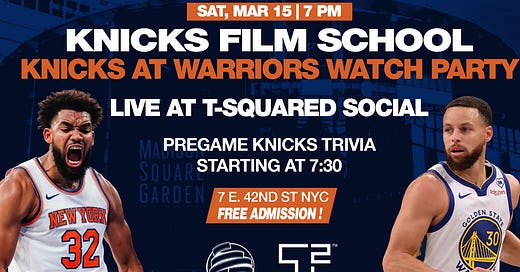The Josh Hart Conundrum
The Knick won Wednesday night, in part because of Josh Hart and in part despite him. Are they doing everything possible to maximize his strengths and minimize his weaknesses?
Good morning! Hope everyone caught up on sleep. The Knicks are back in action tomorrow night in Golden State to finish off their West coast swing. Anyone in the NYC area should come on down to T2 Social where we’ll be doing Knicks trivia at 7:30 leading all the way up to tip off at 8:30. Hope to see you there.
The Josh Hart Conundrum
A little more than two years ago, the Portland Trail Blazers dealt Josh Hart to the New York Knicks. Almost immediately, the return they received was lampooned.
Giving up Cam Reddish and a draft pick that wound up being used on back-end rotation guy, the Knicks got back a player who became a fan favorite before he even unpacked his bags. Counting the playoffs, New York had 109 wins and 107 losses under Thibs before Hart’s arrival. Since he got here, they’re 119-73. He received some token All-Star buzz this year, already has the fourth most triple doubles in franchise history, and is top-20 in the NBA in more than one major advanced statistical category.
And despite all that, there are times when you watch the one-of-one wing and understand not only Portland’s decision (which was made, not coincidentally, ahead of Hart’s extension-eligible summer), but also why they didn’t get more for his services. When you factor in that Hart was dealt following a 26-game stretch in which he shot 24 percent from deep on just 2.4 attempts per game, the picture becomes even clearer.
Fast forward to now, with Hart once again struggling to overcome a crisis of confidence. Following a 4-for-6 night from deep in Sacramento, Hart drained his first two threes in Portland. Even with those positive results though, the hesitancy remained, with his third attempt not coming until the clock was running out on the third quarter. It set up a very clear blueprint for the Blazers once Hart checked back into the game with just over seven minutes left in the fourth.
What transpired from there was perhaps the most revealing stretch of offensive basketball from the Knicks this season. Hart was involved in nearly every single offensive possession for the rest of the game - a tacit acknowledgment that ignoring the problem would not make it disappear.
Let’s go through what we learned over those final 12+ minutes using 11 clips, starting with the very first attempt after Hart returned from the bench:
The default move for the entirety of the rest of the game was to bring Hart into the action as the screener, as we see here. Getting an open Bridges mid-ranger was often the result, which might not be the worst thing for an offense currently missing its lead dog.
Here, the shot misses, but we do get to see one tangential benefit that comes when teams slot their center on Hart, which is that the offensive glass opens up. It led to three of New York’s 22 second chance points in the game.
On the next possession, we see the benefit of a ball that never stops moving:
Keep reading with a 7-day free trial
Subscribe to Knicks Film School to keep reading this post and get 7 days of free access to the full post archives.





